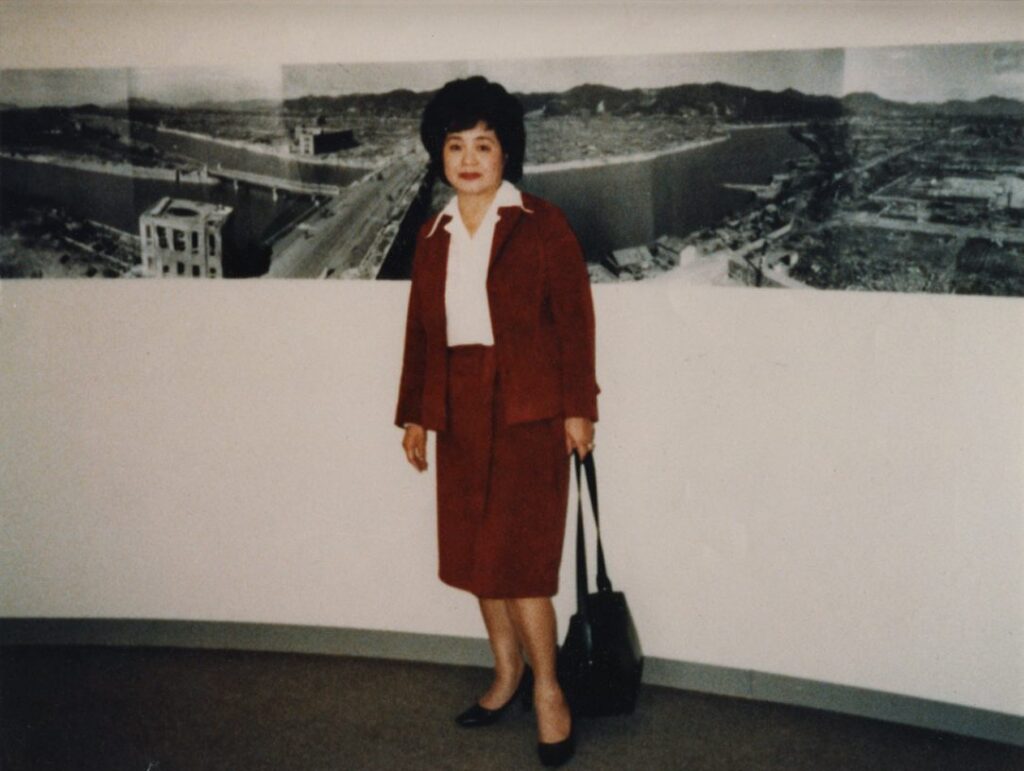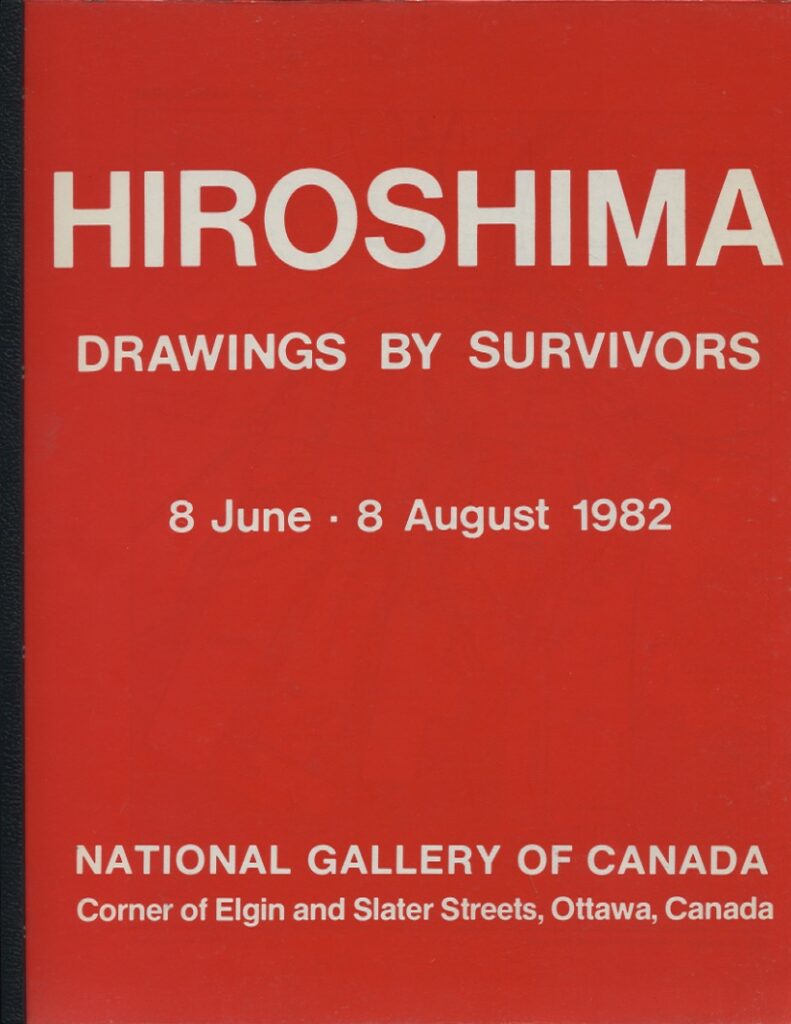Bomb Threat:
Survivors Picture the Nuclear Age
They filled the streets of Manhattan and Central Park, with estimates of three quarters of a million gathered to protest nuclear weapons. The rally had been called by a network of peace organizations, including the Canadian Voice of Women for Peace (VOW) in support of the United Nations Second Special Session on Disarmament. Toronto social worker, disarmament activist, and Hiroshima survivor, Setsuko Thurlow, had to get there. But first, she was engaged to speak at the National Gallery of Canada’s opening reception of Hiroshima: Drawings by Survivors, on view from 8 June to 8 August, 1982. She was invited by Brydon Smith, Assistant Director of Collections and Research and curator of the show. Setsuko had been of great service to Smith when he visited the Hiroshima Peace Memorial Museum to choose the images for the show. Better known as a curator of American abstract art and most well-known for his controversial purchase of Barnett Newman’s Voice of Fire for the National Gallery in 1990, Smith diverged from his usual interests in bringing the Hiroshima exhibition to Ottawa. The 8.5-by-11 inch booklet accompanying the show was a collection of type-written sheets with the names of the artists, titles of works and extended captions numbering 45 pages. Smith’s name does not appear anywhere, nor is there a curatorial statement, other than the following: “The texts contained in the booklet are the words of the artists themselves, in translation. Most are complete versions of the texts that appear on the drawings; the others are either separate commentaries written to accompany the drawings or oral reports taken down when the pictures were brought to the Japan Broadcasting Corporation.” The cover of the booklet is blood red.
* * *
When Setsuko Thurlow arrived in Ottawa the evening before the reception, she was pleased to meet other hibakusha—the Japanese term used to designate a survivor—including the Suzuko Numata, who would sit in her wheelchair under the Chinese parasol tree in the Hiroshima Peace Park day after day telling young people how she lost her legs in the atomic bombing. The next morning Setsuko spoke at the National Gallery reception as planned. She cut an elegant figure, somehow incongruous with pictures of devastation all around her. However, she could not linger as she had to catch a flight from Pearson Airport to Des Moines, Iowa, later that day. She was to give a lecture to 600 church ministers in Des Moines about the immorality of nuclear weapons, and then from there she was to go on to the New York gathering for the UN Special Session on Disarmament. Setsuko got to Pearson in plenty of time. When she stood before the customs agent, he took one look and disappeared with her passport. As the minutes ticked by, she became nervous, then agitated. She had heard that a colleague, Kay Macpherson, formerly the president of the Voice of Women in Canada, had been stopped at the U.S. border while crossing at Champlain N.Y. After an hour the customs agent returned and tossed her passport back at her, claiming “You see, my country is full of peaceniks.” Then he said she was free to go. Knowing she had missed her flight, she insisted that he take her to the top immigration official. Setsuko told the supervisor she knew the 1952 McCarran Act, a McCarthy era bludgeon, was being used to keep undesirables—Communists, lepers, prostitutes and peace activists—from entering the country. Taken aback, he apologised, aware that she knew what she was talking about. Feeling defeated, she then called her husband, who gently reminded her that 600 church ministers were gathering to hear her speak. She left on the next flight to Chicago and spent the night on a bench in O’Hare airport, catching the first flight out to Des Moines, in time for her 9 a.m. session with the ministers. When Setsuko finally made it to the U.N. she again met the Hiroshima group who had attended the opening reception at the National Gallery in Ottawa. Pleased to see her, one colleague exclaimed “So glad to see you made it in one piece.” When pressed he told Setsuko, “Right after you left we all had to evacuate the gallery. Someone called in a bomb threat.”
* * *
I met Setsuko Thurlow in 2017 and she immediately invited me to join the Hiroshima-Nagasaki Day Coalition (HNDC). After a decade developing my own art projects dealing with the Hiroshima and Nagasaki bombings, I was thrilled to find this organisation in my own city. Part of the work done by the HNDC is advocating for nuclear abolition and part is planning commemorative events each year at the Toronto Peace Garden located on Nathan Phillips Square at City Hall. A display of survivor drawings is always a part of those events. Set up in the City Hall Rotunda, the drawings bear witness to the bombings as only hibakusha testimonials can.
* * *
As I reflect upon the first showing of the Drawings by Survivors at the National Gallery of Canada and Setsuko’s story about the bomb threat, the use of the McCarran Act, and the great swell of support for nuclear abolition, I see parallels with the murder of George Floyd, the pandemic that is upon us, and the groundswell of support for true justice. At the same time, I am reminded of the powerful resistance that still needs to be overcome: Just as we must agree to zero tolerance for racism, there is no justification for the use of weapons of mass destruction. This view does not align with the idea that the bombs “saved lives” and “ended the war.” Classified and historical records now show that in July, the Japanese were already defeated and had for months been seeking terms for surrender with assurances of retaining the emperor, a semi-divine figurehead. Today, most historians of the Pacific War agree that the bombs were used in Japan as a diplomatic tool – to demonstrate American might in the face of an ambitious and expansionist USSR. When Stalin declared war on Japan the same day that Nagasaki was bombed, the Japanese knew surrender to the Americans would be far better than a communist takeover.
Japan surrendered on August 15th. The battle for survival among the hibakusha had just begun. For seven years they suffered in silence under the U.S. Occupation Press Code, which forbade discussion of the bombs in any form. Locked deep in their collective psyche, the images from that day were too terrible to describe. Due to many factors, those memories were repressed until the time when some survivors began telling their stories in support of a growing anti-nuclear movement in Japan. This was ignited in 1954 by the irradiation of The Lucky Dragon, a Japanese fishing boat caught in the deadly fallout of the Bravo Hydrogen bomb test near the Bikini Atoll. By the seventies, the Japanese movement had gained terrific momentum. The drawings first emerged in 1974. As historian John Dower explains:
It began … when a survivor visited the Hiroshima office of the Japan Broadcasting Corporation (NHK) to give them a picture he had drawn of a scene from 1945 that still haunted him. This prompted NHK to solicit other such graphic recollections, and these became the basis for a television program and exhibition in Hiroshima in August 1975. Eventually, several thousand such pictures were collected and exhibited throughout the country. ¹
Drawings by survivors show what no documentary photograph ever can. Straight from the mind’s eye, they express the power of memory, trace, and embodied witnessing. They are difficult to look at and impossible to forget. Never again! they scream, they whisper, they cry. No More Hiroshima’s. No More Nagasaki’s.
* * *
To err is human. To err again with nuclear weapons could spell the end of humanity. These drawings offer us a glimpse of a terrible past—let us not allow them to foretell our future.
Katy McCormick
Associate Professor, Ryerson University
August 4, 2020


¹ John W. Dower, Ground Zero 1945: Pictures of the Atomic Bomb Survivors, MIT Visualizing Cultures. Accessed August 3, 2020, https://visualizingcultures.mit.edu/groundzero1945/gz_essay01.html.